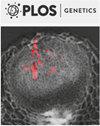谷胱甘肽进口系统满足了金黄色葡萄球菌对营养硫的需求,促进了种间竞争。
IF 3.7
2区 生物学
Q1 Agricultural and Biological Sciences
引用次数: 3
摘要
硫是细菌繁殖不可缺少的元素。先前的研究表明,人类病原体金黄色葡萄球菌利用谷胱甘肽(GSH)作为营养硫的来源;然而,谷胱甘肽获取的机制尚未明确。在这里,我们确定了一个由假定的abc转运蛋白和预测的γ-谷氨酰转肽酶(ggt)组成的五个基因位点,该位点在添加还原或氧化GSH (GSSG)作为营养硫的唯一来源的培养基中促进金黄色葡萄球菌增殖。基于这些表型,我们将这种转运体操纵子命名为谷胱甘肽进口系统(gisABCD)。Ggt在gisBCD操纵子内编码,我们发现该酶能够以GSH或GSSG作为底物释放谷氨酸,证明它是一种真正的γ-谷氨酰转肽酶。我们还确定Ggt在细胞质中表达,这仅代表了细胞质中Ggt定位的第二个例子,另一个是脑膜炎奈瑟菌。生物信息学分析显示,与金黄色葡萄球菌密切相关的葡萄球菌编码GisABCD-Ggt同源物。但在表皮葡萄球菌中未发现同源系统。因此,我们确定GisABCD-Ggt以依赖GSH和gssg的方式为金黄色葡萄球菌提供了相对于表皮葡萄球菌的竞争优势。总的来说,本研究描述了金黄色葡萄球菌中营养硫获取系统的发现,除了GSH外,该系统还针对GSSG,并促进与其他葡萄球菌的竞争,这些葡萄球菌通常与人类微生物群相关。本文章由计算机程序翻译,如有差异,请以英文原文为准。
The glutathione import system satisfies the Staphylococcus aureus nutrient sulfur requirement and promotes interspecies competition.
Sulfur is an indispensable element for proliferation of bacterial pathogens. Prior studies indicated that the human pathogen, Staphylococcus aureus utilizes glutathione (GSH) as a source of nutrient sulfur; however, mechanisms of GSH acquisition are not defined. Here, we identify a previously uncharacterized five-gene locus comprising a putative ABC-transporter and γ–glutamyl transpeptidase (ggt) that promotes S. aureus proliferation in medium supplemented with either reduced or oxidized GSH (GSSG) as the sole source of nutrient sulfur. Based on these phenotypes, we name this transporter the Glutathione import system (GisABCD). We confirm that Ggt is capable of cleaving GSH and GSSG γ–bonds and that this process is required for their use as nutrient sulfur sources. Additionally, we find that the enzyme is cell associated. Bioinformatic analyses reveal that only Staphylococcus species closely related to S. aureus encode GisABCD-Ggt homologues. Homologues are not detected in Staphylococcus epidermidis. Consequently, we establish that GisABCD-Ggt provides a competitive advantage for S. aureus over S. epidermidis in a GSH-dependent manner. Overall, this study describes the discovery of a nutrient sulfur acquisition system in S. aureus that targets GSH and promotes competition against other staphylococci commonly associated with the human microbiota.
求助全文
通过发布文献求助,成功后即可免费获取论文全文。
去求助
来源期刊

PLoS Genetics
生物-遗传学
CiteScore
8.10
自引率
2.20%
发文量
438
审稿时长
1 months
期刊介绍:
PLOS Genetics is run by an international Editorial Board, headed by the Editors-in-Chief, Greg Barsh (HudsonAlpha Institute of Biotechnology, and Stanford University School of Medicine) and Greg Copenhaver (The University of North Carolina at Chapel Hill).
Articles published in PLOS Genetics are archived in PubMed Central and cited in PubMed.
 求助内容:
求助内容: 应助结果提醒方式:
应助结果提醒方式:


